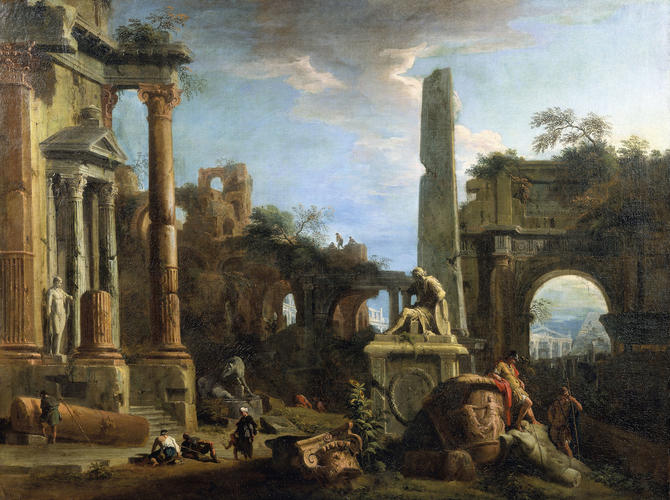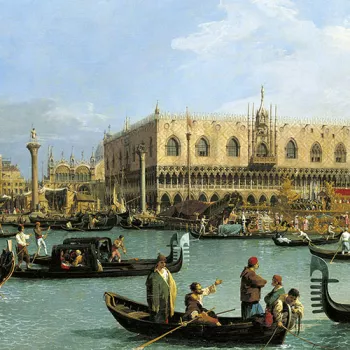Caprice View with Roman Ruins Signed and dated 1729
Oil on canvas | 104.1 x 138.4 cm (support, canvas/panel/stretcher external) | RCIN 404141

Marco Ricci (Belluno 1676-Venice 1730)
Caprice View with Roman Ruins Signed and dated 1729
-
The portico on the left in this painting is based on the ancient Roman Temple of Antoninus and Faustina on the Via Sacra, dedicated to the Emperor and his wife in AD 161 and converted to the church of San Lorenzo in Miranda by the eleventh century. Beyond it are the ruins of the third-century Baths of Caracalla. The triumphal arch on the right is based on the Arch of Titus; through it can be seen the façade of a temple. As with all Marco Ricci's capricci with Roman ruins, the details are based on well-known examples but are not exact copies: the torso on the right resembles the famous Torso Belvedere, the sculpture of a standing man on the left is similar to a statue of Antoninus, and the central seated statue echoes the Ludovisi Mars, which was in the Villa Ludovisi in the eighteenth century. The statue of the wolf with Romulus and Remus is an invention and not based on the famous antique example in the Musei Capitolini, Rome. Nor has the urn or vase with dancing women been identified, but there is a similar vase in Panini's Roman Ruins with People in Discussion with Philosopher and Apostle of 1742 (National Gallery of Ireland).
The entry in the 'Italian List' states that this was a collaborative work between Marco and Sebastiano and that it was Marco's last work. The late date is confirmed stylistically by the atmospheric light that subtly modulates forms, defining with intensity details such as the seated sculpture, and elsewhere dissolving into a suggestive haze where, for example, the evening light slants across the Arch of Titus or casts shadows on the Baths of Caracalla. Indeed, the transforming light in Marco's paintings was his greatest contribution to eighteenth-century Venetian art. Sebastiano frequently painted some of the figures in Marco's landscapes, generally the most prominent in the foreground. Here the two soldiers near the sculpted torso have the substance of Sebastiano's figures.
In Marco's ruin paintings, whether in oil or tempera, the same motifs, ruins and sculptures reappear. They are populated by contemporary characters going about their everyday lives, on a small scale compared to their surroundings. Here there are also two Roman soldiers, figures from the past, who alone seem to understand the immensity of what has been lost as they stand in silent contemplation of a glorious age. This sense of nostalgia is reinforced by the setting sun on the decaying ruins, giving an elegiac quality to the scene as a whole.
Text adapted from Canaletto & the Art of Venice, 2017.Provenance
Acquired in 1762 by George III from Joseph Smith, British Consul in Venice (Italian List no 109, which describes the figures as Sebastiano Ricci); recorded in the King's Dining Room at Kew in 1805 as Panini (no 5), corrected to Marco Ricci when described in the same place in 1828 (no 1216)
-
Medium and techniques
Oil on canvas
Measurements
104.1 x 138.4 cm (support, canvas/panel/stretcher external)
130.7 x 163.2 x 12.5 cm (frame, external)
Category
Object type(s)








